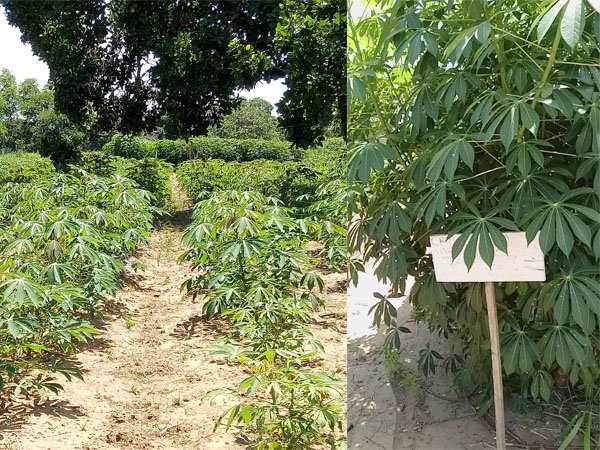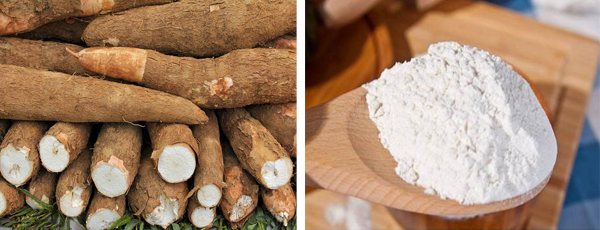What is cassava flour used for?
We have heard that there used to be a factory in Belize that produced cassava flour for sale. Families in Upper Barton Creek and daughter settlements have been producing cassava flour for home use for over 40 years. Drying cassava for flour takes effort, but it’s an enjoyable job the whole family can help with. It’s a good way to spend time together while producing a useful food! Cassava flour can be used successfully to make pancakes, muffins, cakes, cookies, corn bread and other quick-rise baked goods. Its by-product, cassava starch, also has many uses.
 Cassava
Cassava
Processing cassava flour at home:
To make cassava flour, we dry cassava in the dry season when we have dependably sunny weather. The mature cassava roots are first harvested and peeled. To make full use of a sunny day, this job can be done the day before and the peeled roots left overnight in tubs, completely covered with water. The next step is to shred or chop up the roots finely. There would be a variety of methods for this which would work, but in our communities it is most commonly done either by using a hand operated rotary shredder of the type known as Salad Master, or by the horsepower using the machine designed for chopping sugar cane for feed. The more finely shredded the cassava is, the more starch can be extracted. The resulting shredded pulp is washed in two or three changes of water to wash out the starch. While cassava can be dried with the starch intact, the washing process yields a flour which is lighter, with less of the”rubbery” consistency which whole cassava naturally has. After the cassava pulp is removed and the water has become quite starchy from several batches of pulp, it should be left to set in containers so the starch may settle. Before being set aside, any settled starch should be stirred up from the bottom and the water poured through a fine strainer to remove any remaining shreds of cassava from the water. Starch particles are extremely fine and will pass through the strainer. When the water is left to set, after an hour or so there will be a thick layer of starch at the bottom of the container and the water, which will be a watery yellow instead of white, can be poured off. The gooey starch at the bottom can be sooped out and crumbled onto pans to dry in the sun. Once you have worked with wet starch you will understand how a thing can be both gooey and crumbly! Starch is indeed a fascinating substance.
As the cassava is washed and squeezed out, it may be spread on clean sheets of tin to dry in the sun. At least once over the course of a sunny day it should be stirred around by hand dto ensure even drying. Drying of starch can be done in one day but the shredded cassava, squeezed out firmly after washing, usually requires 2 sunny days. It should be covered at night with tarps or additional tins. The cassava is sufficiently dry when it is brittle instead of flexible. Dried cassava and cassava starch should be stored in tight containers when completely dry and crispy.
The final step is to grind your dried cassava. The courser siftings may be used in place of bread-crumbs or rolled oats in recipes where such things are used as a binder, for example in meat loaf, casseroles or any patties.
 Cassava flour
Cassava flour
What is cassava flour used for?
Now you are ready to use your cassava flour. You may try any of your favorite recipes using cassava flour instead of white or whole wheat flour. In general a thinner batter works better for cassava, so try adding a little more milk or water than the recipe calls for. A portion of corn meal, up to one half – in muffins or other quick brads seems to blend well with cassava, counteracting cassava’s “gluey” nature. Corn tortillas are actually improved by the addition of cassava flour, half a cup or more per hopper of corn. Since cassava contains no gluten it cannot be used alone in yeast bread, but a portion of cassava flour can be successfully added to bread recipes.
A very acceptable rolled pastry dough, for example for pie crust, can be made using one part cassava flour, one part corn meal and one part white flour in your favorite recipe. Cassava starch, which does not need to be ground, can be used in place of corn starch or flour as a thickener in stews, gravies and puddings. Sprinkle it, chunks and all, into boiling fruit juice or sweetened milk for a tapioca effect. In fact, do you know where tapioca came from? It is made from our humble friend, the cassava. How wonderful that God has given us such a prolific crop that can be used in such a variety of ways! Let us show our thankfulness by reducing our dependence on imported white flour products which are costly and so much less wholesome.
PREV:What's the difference? flour,cornstarch, potato starch,and arrowroot
NEXT:What's the difference between three-column centrifuge and garri presser?
Leave a message
- WhatsApp:
+8613526615783
- Email:
sales@doinggroup.com
- Tel:
0086 135 2661 5783
- Phone:
0086 371 5677 1822
- Skype:
elina881130
- Address:
No.133 Yaozhai Road, Jinshui District, Zhengzhou City, Henan Province, China
-
 What is high quality cassava flour, how to produce high quality cassava flour ?
What is high quality cassava flour, how to produce high quality cassava flour ?
-
 Cassava starch manufacturing process
Cassava starch manufacturing process
-
 How to process cassava into cassava chips ?
How to process cassava into cassava chips ?
-
 Which kind of cassava peeling machine popular in Nigeria ?
Which kind of cassava peeling machine popular in Nigeria ?
-
 How to maintain cassava starch processing equipment ?
How to maintain cassava starch processing equipment ?
-
 How to extract cassava starch ?
How to extract cassava starch ?
-
 What is cassava flour used for?
What is cassava flour used for?
-
 How to make cassasva starch?
How to make cassasva starch?
-
 Water, electricity, steam and land deploy in starch processing plant
Water, electricity, steam and land deploy in starch processing plant
-
 How profitable is cassava starch made?
How profitable is cassava starch made?
-
 What is high quality cassava flour, how to produce high quality cassava flour ?
What is high quality cassava flour, how to produce high quality cassava flour ?
-
 How to process cassava into cassava chips ?
How to process cassava into cassava chips ?
-
 Cassava starch manufacturing process
Cassava starch manufacturing process
-
 How to maintain cassava starch processing equipment ?
How to maintain cassava starch processing equipment ?
-
 How to extract cassava starch ?
How to extract cassava starch ?
-
 How to make cassasva starch?
How to make cassasva starch?
-
 Water, electricity, steam and land deploy in starch processing plant
Water, electricity, steam and land deploy in starch processing plant
-
 How profitable is cassava starch made?
How profitable is cassava starch made?
Leave a message

Tel/Whatsapp:
+8613526615783



